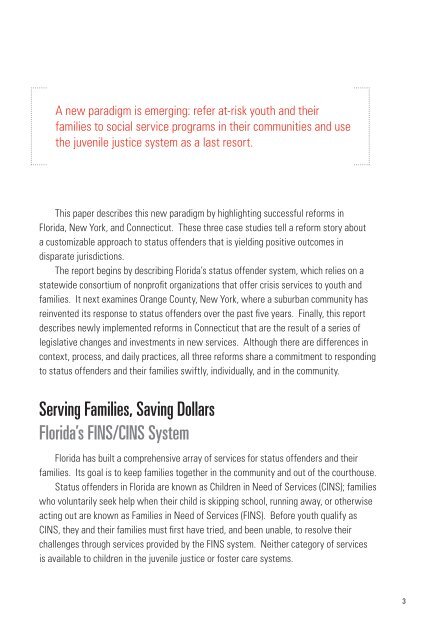A new paradigm is emerging: refer at-risk youth and <strong>the</strong>irfamilies to social service programs in <strong>the</strong>ir communities and use<strong>the</strong> juvenile justice system as a last resort.This paper describes this new paradigm by highlighting successful re<strong>for</strong>ms inFlorida, New York, and Connecticut. These three case studies tell a re<strong>for</strong>m story abouta customizable approach to status offenders that is yielding positive outcomes indisparate jurisdictions.The report begins by describing Florida’s status offender system, which relies on astatewide consortium of nonprofit organizations that offer crisis services to youth andfamilies. It next examines Orange County, New York, where a suburban community hasreinvented its response to status offenders over <strong>the</strong> past five years. Finally, this reportdescribes newly implemented re<strong>for</strong>ms in Connecticut that are <strong>the</strong> result of a series oflegislative changes and investments in new services. Although <strong>the</strong>re are differences incontext, process, and daily practices, all three re<strong>for</strong>ms share a commitment to respondingto status offenders and <strong>the</strong>ir families swiftly, individually, and in <strong>the</strong> community.Serving Families, Saving DollarsFlorida’s FINS/CINS SystemFlorida has built a comprehensive array of services <strong>for</strong> status offenders and <strong>the</strong>irfamilies. Its goal is to keep families toge<strong>the</strong>r in <strong>the</strong> community and out of <strong>the</strong> courthouse.Status offenders in Florida are known as Children in Need of Services (CINS); familieswho voluntarily seek help when <strong>the</strong>ir child is skipping school, running away, or o<strong>the</strong>rwiseacting out are known as Families in Need of Services (FINS). Be<strong>for</strong>e youth qualify asCINS, <strong>the</strong>y and <strong>the</strong>ir families must first have tried, and been unable, to resolve <strong>the</strong>irchallenges through services provided by <strong>the</strong> FINS system. Nei<strong>the</strong>r category of servicesis available to children in <strong>the</strong> juvenile justice or foster care systems.3
Although <strong>the</strong> Florida Department of Juvenile Justice (DJJ) manages FINS/CINSservices, all services provided to this population are privatized. DJJ contracts with <strong>the</strong>Florida Network of Youth and Family Services, Inc., (<strong>the</strong> Network) — a statewide nonprofitassociation representing 32 community-based agencies that serve troubled juvenilesand <strong>the</strong>ir families — to oversee both programs. Network services include non-residentialintervention and outreach services, as well as respite shelters at most locations. The fullcontinuum of residential and non-residential services is available 24 hours a day, sevendays a week.The FINS/CINS process begins when a youth and family make contact with a Networkprovider. 1 Although some seek out <strong>the</strong> contact <strong>the</strong>mselves, most are referred, usually bylaw en<strong>for</strong>cement or school staff. Upon establishing contact, <strong>the</strong> youth and family receiveimmediate crisis intervention to assess <strong>the</strong>ir eligibility <strong>for</strong> services and <strong>the</strong>ir psychologicaland social needs. After <strong>the</strong> assessment, <strong>the</strong> youth and family may be offered a rangeof interventions, including a bed in a runaway or crisis shelter, or o<strong>the</strong>r non-residentialservice options, such as referrals to case management services.If, after some time, FINS interventions are insufficient to address <strong>the</strong> family crisis,Network providers convene a conference with <strong>the</strong> child, parents, school staff, a DJJrepresentative, and o<strong>the</strong>r family advocates to identify next steps. Toge<strong>the</strong>r, <strong>the</strong>y decidewhe<strong>the</strong>r to alter or extend <strong>the</strong> service plan, refer <strong>the</strong> youth to o<strong>the</strong>r community orgovernment prevention services, close <strong>the</strong> FINS case without fur<strong>the</strong>r involvement, or send<strong>the</strong> matter to juvenile court to be considered as a CINS case. Should <strong>the</strong> case go to courtand qualify as a CINS, judges may order <strong>the</strong> youth to participate in treatment and servicesor place him or her in a secure shelter <strong>for</strong> up to 90 days. 2 In practice, however, few youthand families require this level of intervention. In each of <strong>the</strong> past three years, only about6 percent of FINS cases were petitioned to court as CINS. 3The Network requires participating providers to report comprehensive per<strong>for</strong>mancein<strong>for</strong>mation, which it collects through a centralized, statewide database. It, in turn,submits monthly and more detailed quarterly reports to DJJ. The Network alsoaggregates, analyzes, and publishes statistics in an in-depth annual report. This oversightensures that providers are meeting established per<strong>for</strong>mance benchmarks. In particular,providers must show that at least 90 percent of youth are not arrested <strong>for</strong> committing acrime during <strong>the</strong> time <strong>the</strong>y are receiving services, and that 85 percent do not commit acrime within six months of exiting <strong>the</strong> program. The providers also seek to verify that 60percent of all services are provided to young people who reside in high-crime zip codes.To date, Florida’s approach to treating troubled youth and <strong>the</strong>ir families has beensuccessful. In fiscal year 2005-2006, <strong>the</strong> most recent year <strong>for</strong> which data is available,96 percent of youth served by <strong>the</strong> Network were crime-free while receiving services,4<strong>Making</strong> <strong>Court</strong> <strong>the</strong> <strong>Last</strong> <strong>Resort</strong>: A New Focus <strong>for</strong> Supporting Families in Crisis
















